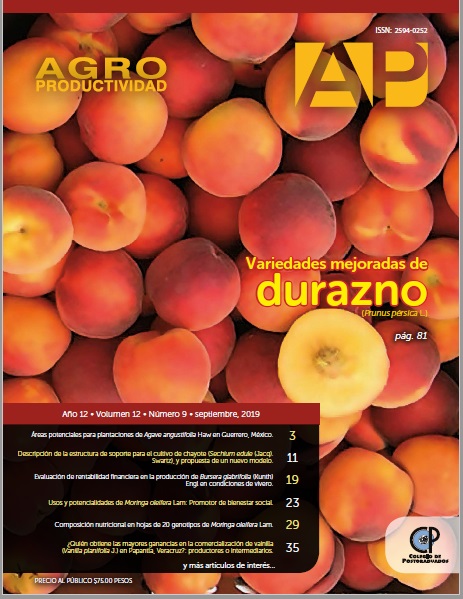NUTRITIONAL COMPOSITION IN LEAVES OF 20 GENOTYPES OF MORINGA Moringa oleifera Lam.
Main Article Content
Keywords
Moringa oleifera, nutritional facts, leaves.
Abstract
Objective: Determine the nutritional composition of fresh and dehydrated leaves of 20 Moringa oleifera Lam genotypes.
Design/morphology/approach: The vegetative material was obtained from three-year-old trees of 20 genotypes of Moringa oleifera, stablished in the Experimental station Rosario Izapa of INIFAP. For the proximal analysis, the standardized methods recommended by national and international standards were used.
Results: The highest nutrient content was found in the dehydrated leaves, in which high average contents of crude protein were found (26.9 g/100g); calcium (2560.8 mg/100g); iron (12.5 mg/100g) and potassium (1976 mg/100g), as well as acceptable average crude fiber contents (9.5 g/ 100/g); fat (5.7 g/100g); carbohydrates (42.9 g/100g); energy value (330.4 kcal/ 100g); zinc (4.9 mg/100g); sodium (95.1 mg/100g); magnesium (408.3 mg/100g) and phosphorus (271.6 mg/100g). The highest contents of crude protein, zinc, potassium and phosphorus, iron and calcium were registered in the genotypes RIMOR10 and RIMOR 6.
Limitations on the study /implications: It is necessary to verify the nutritional content of moringa leaves in other environmental conditions different from the study area.
Findings/conclusions: Dehydrated moringa leaves have a high content of crude protein, iron, calcium and potassium, as well as acceptable contents of crude fiber, fat, carbohydrates, energy value, zinc, sodium, magnesium and phosphorus, higher than other foods, so that its consumption is considered a viable alternative to complement the traditional diet to reduce the problem of malnutrition in Mexico.

